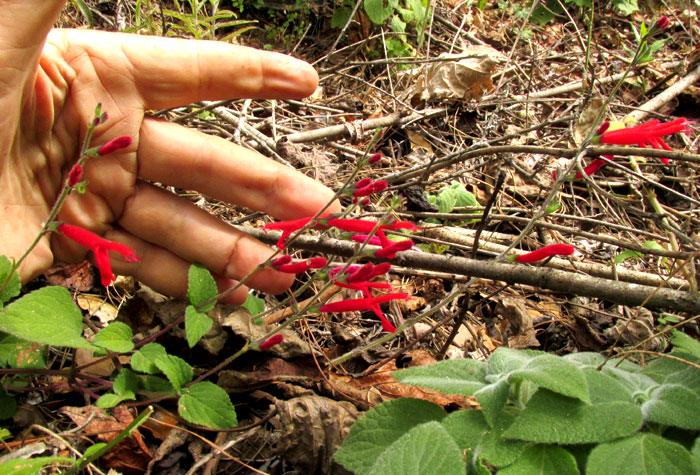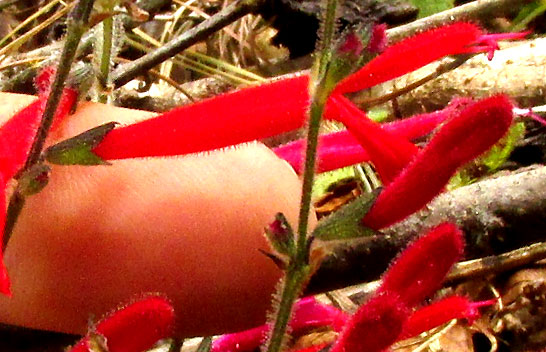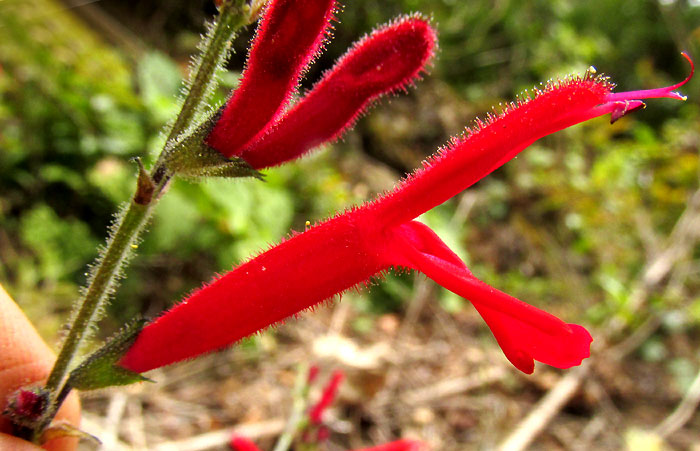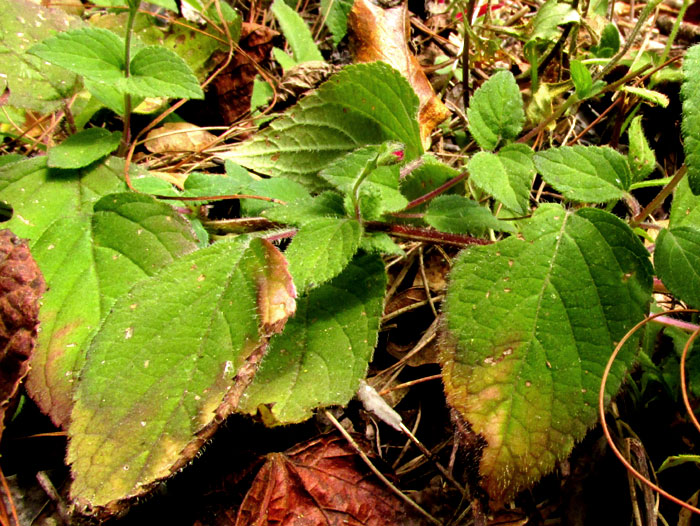Excerpts from Jim Conrad's
Naturalist Newsletter
entry from field notes dated January 19, 2023, taken along steep, one-lane gravel road ascending forested, northeast-facing mountain slope, elevation ±2,380m (7600 ft); bedrock of Cretaceous limestone; on the south side of Pinal de Amoles, Querétaro state, MÉXICO, (N21.134°, W99.629°)
PINEAPPLE SAGE

On a steep slope forested mostly with pines, the above sage, genus Salvia, produced stems which reclined on the ground. The red flowers' particular form and arrangement in the inflorescence -- the flowers bearing only two stamens mostly hidden by the corolla's straight upper lip -- indicated that this was one of many species of the Mint Family genus Salvia. Salvia flowers are quintessential hummingbird-pollinated blossoms.
 In upland central Mexico we have so many Salvia species, with several producing red flowers similar to these, that it can be hard to determine which species you have. For that reason, the picture at the right is useful because it shows my middle finger next to a flower. In real life my finger is 17mm across at its widest part in the picture. Knowing that, and measuring the width of my finger in the picture, and the length of the corolla in the picture, a little algebra reveals that in real life the corolla is 35 mm long. The same technique shows that the calyx is 7mm long. Here's a flower picture without the finger:
In upland central Mexico we have so many Salvia species, with several producing red flowers similar to these, that it can be hard to determine which species you have. For that reason, the picture at the right is useful because it shows my middle finger next to a flower. In real life my finger is 17mm across at its widest part in the picture. Knowing that, and measuring the width of my finger in the picture, and the length of the corolla in the picture, a little algebra reveals that in real life the corolla is 35 mm long. The same technique shows that the calyx is 7mm long. Here's a flower picture without the finger:

Among central Mexico's red-flowered Salvia species, our plant's corolla is a bit shorter than some, and the calyx is much shorter. The calyx's shortness relative to the corolla length is a good field mark. Our plant's corollas and stems are markedly covered with sticky, gland-tipped hairs, but glands seem to come and go among the cluster of species our plant belongs to. Also in the above picture, an important feature is that the sharp-pointed, scale-like bract at the base of the flowers' pedicels is small, and ready to fall off. Yet another important feature is that the tips of the above flower's calyx lobes end in sharp, hard "cusps." And here are some leaves, a bit ragged and turning brown after a rainy season that never developed, and it now being a very dry dry-season now:

The larger leaves bear short, backward-projecting lobes at their bases, are broadly egg-shaped and their margins are toothed, or serrate.
All these details and more point to SALVIA ELEGANS, fairly commonly found at higher elevations, especially in pine, oak, fir and deciduous forests, from northwestern Mexico south to about Honduras. On the Internet, English-using websites consistently refer to Salvia elegans as Pineapple Sage, the UK's Royal Horticultural Society saying, "leaves strongly pineapple-scented." Others describe a faint taste, and I didn't think to taste them. In various countries the species is a gardening favorite, and different cultivars are sold, such as 'Tangerine' with a different flavor, 'Frieda Dixon' with salmon pink flowers instead of red, and 'Golden Delicious' with bright chartreuse leaves instead of green.
In Mexico, where one of its names is Hierba del Burro, or "Burro's Plant," the medicinal uses of Salvia elegans seem to be more important than its taste. In the 2006 publication by S. Mora and others entitled "The hydroalcoholic extract of Salvia elegans induces anxiolytic- and antidepressant-like effects in rats," it's stated that in Mexico Salvia elegans is widely used in Mexican traditional medicine to alleviate central nervous system ailments, and that it's claimed to be a “nervous system tonic, both soothing and stimulating, that releases stress, negativity and tension in heightened activity.” The authors conclude that their laboratory experiments "... make evident that the hydroalcoholic extract of the leaves from Salvia elegans exerts sedative and antidepressant effects in rats."